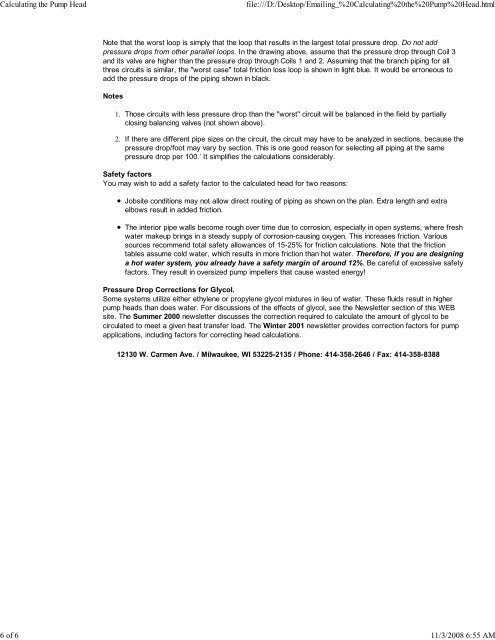Calculating the Pump Head - HVAC.Amickracing
Calculating the Pump Head - HVAC.Amickracing
Calculating the Pump Head - HVAC.Amickracing
Create successful ePaper yourself
Turn your PDF publications into a flip-book with our unique Google optimized e-Paper software.
<strong>Calculating</strong> <strong>the</strong> <strong>Pump</strong> <strong>Head</strong>file:///D:/Desktop/Emailing_%20<strong>Calculating</strong>%20<strong>the</strong>%20<strong>Pump</strong>%20<strong>Head</strong>.html6 of 6 11/3/2008 6:55 AMNote that <strong>the</strong> worst loop is simply that <strong>the</strong> loop that results in <strong>the</strong> largest total pressure drop. Do not addpressure drops from o<strong>the</strong>r parallel loops. In <strong>the</strong> drawing above, assume that <strong>the</strong> pressure drop through Coil 3and its valve are higher than <strong>the</strong> pressure drop through Coils 1 and 2. Assuming that <strong>the</strong> branch piping for allthree circuits is similar, <strong>the</strong> "worst case" total friction loss loop is shown in light blue. It would be erroneous toadd <strong>the</strong> pressure drops of <strong>the</strong> piping shown in black.Notes1.2.Those circuits with less pressure drop than <strong>the</strong> "worst" circuit will be balanced in <strong>the</strong> field by partiallyclosing balancing valves (not shown above).If <strong>the</strong>re are different pipe sizes on <strong>the</strong> circuit, <strong>the</strong> circuit may have to be analyzed in sections, because <strong>the</strong>pressure drop/foot may vary by section. This is one good reason for selecting all piping at <strong>the</strong> samepressure drop per 100.’ It simplifies <strong>the</strong> calculations considerably.Safety factorsYou may wish to add a safety factor to <strong>the</strong> calculated head for two reasons:Jobsite conditions may not allow direct routing of piping as shown on <strong>the</strong> plan. Extra length and extraelbows result in added friction.The interior pipe walls become rough over time due to corrosion, especially in open systems, where freshwater makeup brings in a steady supply of corrosion-causing oxygen. This increases friction. Varioussources recommend total safety allowances of 15-25% for friction calculations. Note that <strong>the</strong> frictiontables assume cold water, which results in more friction than hot water. Therefore, if you are designinga hot water system, you already have a safety margin of around 12%. Be careful of excessive safetyfactors. They result in oversized pump impellers that cause wasted energy!Pressure Drop Corrections for Glycol.Some systems utilize ei<strong>the</strong>r ethylene or propylene glycol mixtures in lieu of water. These fluids result in higherpump heads than does water. For discussions of <strong>the</strong> effects of glycol, see <strong>the</strong> Newsletter section of this WEBsite. The Summer 2000 newsletter discusses <strong>the</strong> correction required to calculate <strong>the</strong> amount of glycol to becirculated to meet a given heat transfer load. The Winter 2001 newsletter provides correction factors for pumpapplications, including factors for correcting head calculations.12130 W. Carmen Ave. / Milwaukee, WI 53225-2135 / Phone: 414-358-2646 / Fax: 414-358-8388















